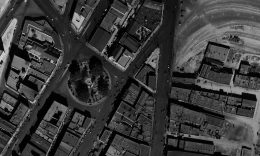
Fifty years ago, the UCSB Library created a separate unit to collect maps and aerial photographs. In 1979, the Map Room was renamed the Map & Imagery Laboratory (MIL) in order to acknowledge its role in supporting research and teaching on campus. In the time since, MIL has evolved into one of the largest unique collections of cartographic materials in the nation. In particular, our collection of historic aerial photographs presents an unparalleled view of landscape change in California and beyond.
For many years, MIL has also been a leader in collecting and advancing digital spatial or Geographic Information Systems (GIS) data. The Alexandria Digital Library (ADL), developed in the mid-1990s with partners from the Geography and Computer Science Departments, among others, was a groundbreaking project that offered one of the first online spatial search functions…well before Google Maps existed.
Spatial data services are now primarily offered in the Interdisciplinary Research Collaboratory, which opened on the 2nd Floor Mountain Side last January to support UCSB researchers working with all types of data. Jon Jablonski, MIL’s librarian, was recently named director of the Collaboratory.
Almost all of the physical maps and aerial photographs have been in off-site storage since the Library broke ground on its Addition & Renovation Project in 2013. Staff retrieve materials upon request to MIL’s temporary quarters on the 1st Floor Ocean Side. Eventually all of the cartographic collections will be moved into environmentally-appropriate storage within the main Library, MIL will vacate its temporary site, and users will request these materials through Special Research Collections.
To prepare for this transition, MIL is closing its public service desk at the end of winter quarter (March 24, 2017) while continuing to provide scheduled access to collection materials. Users can request maps and aerial photographs via the Library Catalog, email (milrefdesk@library.ucsb.edu), and phone (805-893-2779).
Who knows what the next fifty years will bring, but the UCSB Library looks forward to continuing to support spatial research in the years ahead.


